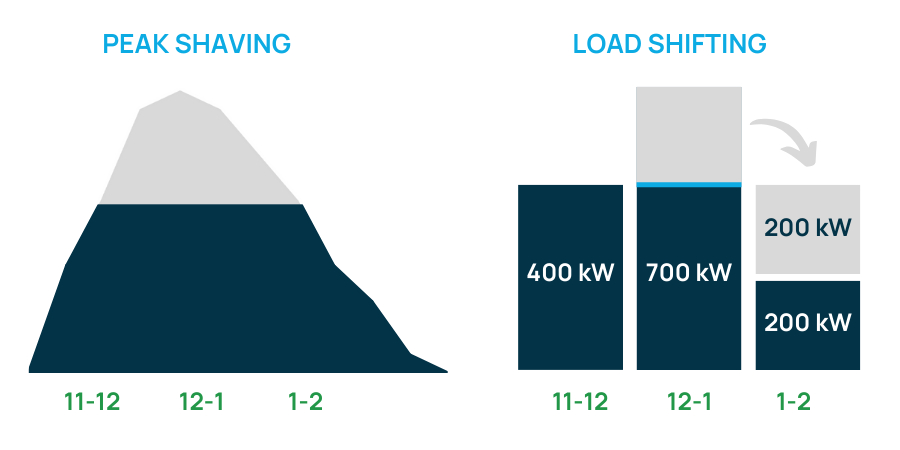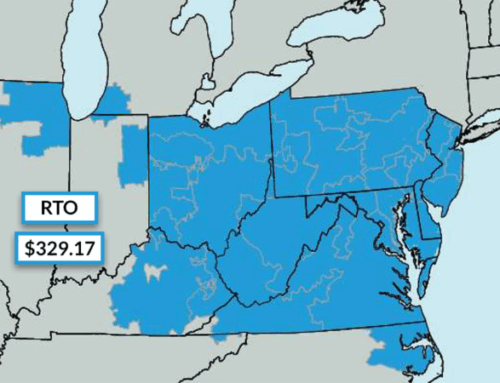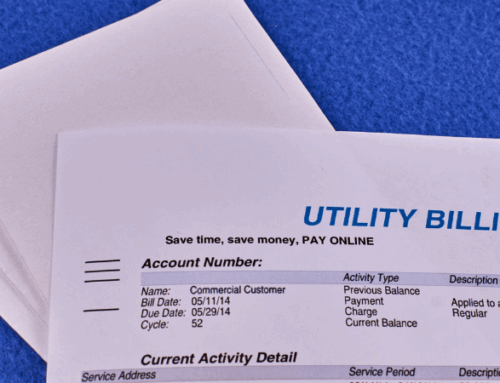As energy costs continue to rise and electric grid reliability becomes increasingly critical, businesses are seeking effective ways to manage their energy consumption. Two popular strategies for managing energy use and reducing costs are peak shaving and load shifting. These methods help businesses minimize demand charges and optimize energy usage, but they operate differently and are suited to different scenarios. Understanding the key differences between peak shaving vs. load shifting, and knowing when to apply each strategy, can significantly impact a business’s energy expenses and overall efficiency. Let’s explore the differences in these strategies and how you can use them to reduce costs.
Peak Shaving vs. Load Shifting: The Key Differences
To effectively manage energy consumption, it’s essential to understand the differences between peak shaving and load shifting. Both strategies aim to reduce energy costs, but they do so in different ways.

What Is Peak Shaving?
Peak shaving is a strategy focused on reducing a facility’s maximum energy demand during peak periods. This method involves either lowering energy consumption or supplementing with alternative energy sources, so the facility is not pulling power from the meter.
How Does It Work?
Peak shaving typically involves the use of on-site energy generation, such as diesel generators or solar panels, and energy storage systems like batteries. During peak demand periods, these systems kick in to reduce the amount of energy drawn from the grid. By doing so, the facility avoids the higher demand charges that come with exceeding peak demand thresholds set by the utility company’s energy tariff.
Pros Of Peak Shaving
- Cost Savings: Peak shaving can lead to significant reductions in demand charges, which are often a substantial part of a commercial electricity bill.
- Grid Stability: By reducing peak demand, businesses help maintain grid stability and avoid contributing to grid overloads.
- Flexibility: Peak shaving allows businesses to manage their energy use without drastically altering operational schedules.
Cons Of Peak Shaving:
- High Initial Costs: Implementing peak shaving strategies often requires significant investment in on-site generation or energy storage systems.
- Maintenance: The systems used for peak shaving, such as generators and batteries, require regular maintenance and can degrade over time.
What Is Load Shifting?
Load shifting is a strategy that involves moving energy consumption from periods of high demand (and high prices) to periods of lower demand (and lower prices). This approach is particularly effective in regions with time-of-use (TOU) pricing, where electricity costs vary throughout the day.
How Does It Work?
Load shifting works by rescheduling energy-intensive activities to off-peak hours. For instance, a commercial laundry facility might shift its laundry processes to nighttime when energy prices are lower. In industries with flexible production schedules, this can lead to substantial savings without the need for significant infrastructure investment.
In a commercial setting, load shifting might involve running air conditioning systems or heavy machinery during the early morning or late evening hours when demand and electricity prices are lower.
Pros Of Load Shifting
- Lower Operational Costs: Load shifting takes advantage of lower energy rates during off-peak times, leading to reduced overall energy costs.
- Ease of Implementation: Unlike peak shaving, load shifting doesn’t require significant capital investment in new technology or equipment.
- Improved Energy Efficiency: By optimizing the timing of energy use, businesses can achieve better overall energy efficiency.
Cons Of Load Shifting
- Operational Disruptions: Shifting energy use to off-peak times may disrupt normal business operations or require changes to work schedules.
- Limited Applicability: Load shifting is only effective for businesses that have the flexibility to adjust their operations.
Applying These Strategies To Different Scenarios
Deciding between peak shaving and load shifting depends on several factors, including the nature of your business, your energy usage patterns, and the structure of your electricity rates.
Peak Shaving
Ideal for businesses with high energy demand that experience significant demand charges. It is especially useful in scenarios where reducing peak demand can lead to considerable cost savings, such as in manufacturing plants or large commercial buildings.
Load Shifting
Best suited for businesses that operate in regions with TOU pricing and have the flexibility to adjust their operations. Industries like data centers, where energy-intensive tasks can be scheduled during off-peak hours, can benefit greatly from load shifting.
Savings Through Peak Shaving & Load Shifting
Businesses can achieve substantial savings by implementing peak shaving and load shifting strategies. These methods not only help reduce overall energy costs but also improve operational efficiency and grid stability. Below are three key ways in which these strategies can lead to significant savings:
Reduce Utility Delivery Charges
One of the primary ways businesses can save through peak shaving is by reducing utility delivery charges. Utilities measure peak demand and typically bill customers based on the highest level of energy usage within each billing period. This peak demand is recorded by the utility and is often the basis for the demand charges on your monthly bill. By lowering peak demand through strategic energy management, businesses can significantly reduce these delivery charges. Since most utility tariffs are structured around peak demand levels, consistently keeping your demand below the peak threshold can result in considerable savings month after month.
Reduce Electric Supply Capacity Costs
Another significant area of savings comes from reducing electric supply costs by managing capacity charges. In many grids, including PJM, capacity costs are determined by a consumer’s peak demand during the summer months. This capacity charge is a substantial component of your overall electricity costs, especially in regions like PJM where capacity rates are set to increase by over 500% for the 2025/2026 year. By lowering your peak demand during these critical summer months, you can reduce your capacity tag, which is used to calculate your capacity costs for the following year. Implementing peak shaving during these times can therefore lead to significant savings on your electric supply costs.
Get Better Supply Rates
Another advantage of reducing your peak demand and lowering your capacity tags is qualifying for better electricity supply rates in deregulated energy markets. Retail electricity suppliers evaluate capacity tags and annual power usage when pricing accounts. In fact, they assign each customer a load factor rating that is based on these numbers. Reducing capacity demand will help you to increase your load factor and get better electric rates.
Lower Energy Usage
In addition to reducing delivery and supply costs, peak shaving and load shifting can help businesses lower their overall energy usage. By reducing peak demand, you’re not only lowering the amount of power drawn from the grid during expensive peak periods but also decreasing your overall energy consumption. Over time, this can lead to lower energy bills as you’re using less power overall. Less energy usage also contributes to a lower carbon footprint, aligning your business with sustainability goals while saving money.
Peak Shaving Strategies & Implementation
To implement an effective peak shaving strategy, businesses should consider the following best practices:
Conduct An Energy Audit
Before implementing peak shaving, conduct an energy audit to identify when and where peak demand occurs. This will help you understand your business energy consumption patterns and pinpoint opportunities for peak shaving.
Invest In Energy Storage
Battery storage systems are a key component of peak shaving. They store energy during off-peak hours and discharge it during peak times, reducing reliance on the grid.
Utilize On-Site Generation
On-site generation, such as commercial solar panels or natural gas generators, can supplement grid power during peak periods. This reduces peak demand and can also provide a backup power source for energy security.
Monitor And Control Energy Use
Implement energy management systems (EMS) to monitor real-time energy use. These systems can automatically control energy consumption, shifting non-essential loads away from peak periods.
Engage In Demand Response
Participating in demand response programs allows businesses to receive incentives for reducing energy use during peak periods – particularly periods tied to energy capacity costs. This not only helps with peak shaving and capacity savings but also provides additional revenue.
Want To Implement A Demand Shaving Strategy?
Understanding the differences between peak shaving vs. load shifting is crucial for businesses looking to optimize their energy demand management strategies. Both methods offer unique benefits and are applicable in different scenarios depending on a business’s operational needs and the structure of its energy costs. Our team of energy experts can help you analyze your energy load, identify your peak periods, and navigate various solutions for peak shaving or energy load shifting. Contact us today to learn more.



